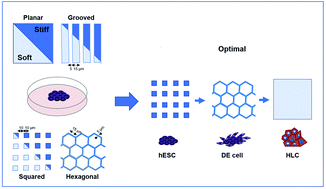Hepatic differentiation of human embryonic stem cells by coupling substrate stiffness and microtopography†
Abstract
Mechanical or physical cues are associated with the growth and differentiation of embryonic stem cells (ESCs). While the substrate stiffness or topography independently affects the differentiation of ESCs, their cooperative regulation on lineage-specific differentiation remains largely unknown. Here, four topographical configurations on stiff or soft polyacrylamide hydrogel were combined to direct hepatic differentiation of human H1 cells via a four-stage protocol, and the coupled impacts of stiffness and topography were quantified at distinct stages. Data indicated that the substrate stiffness is dominant in stemness maintenance on stiff gel and hepatic differentiation on soft gel while substrate topography assists the differentiation of hepatocyte-like cells in positive correlation with the circularity of H1 clones initially formed on the substrate. The differentiated cells exhibited liver-specific functions such as maintaining the capacities of CYP450 metabolism, glycogen synthesis, ICG engulfment, and repairing liver injury in CCl4-treated mice. These results implied that the coupling of substrate stiffness and topography, combined with the biochemical signals, is favorable to improve the efficiency and functionality of hepatic differentiation of human ESCs.



 Please wait while we load your content...
Please wait while we load your content...